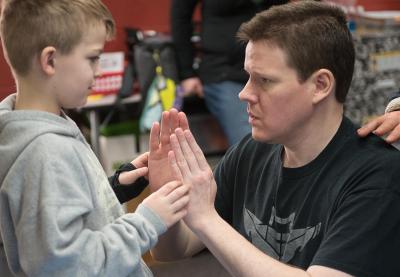Wendy Harris wanted to start a DeafBlind club at her school.
An educator for the deaf and blind, Harris noticed that her DeafBlind students at the Metro Deaf School in St. Paul, Minnesota—one of the top schools for the deaf in the United States—were missing out on some key academic and social experiences. The club, she imagined, could fill those gaps and also raise the overall cultural competency of the school.
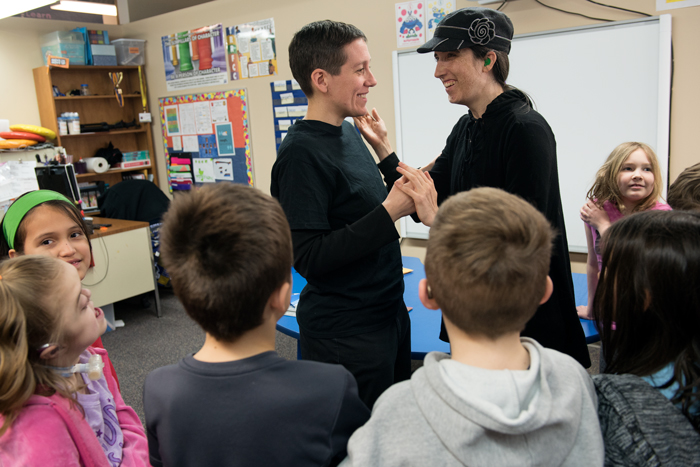
DeafBlindness is relatively rare. According to the National Center on Deaf-Blindness, just 9,635 individuals were counted as DeafBlind in the United States in 2017. Few DeafBlind individuals are completely deaf and blind—most have some residual hearing, vision or both. A common cause of DeafBlindness is Usher syndrome, which involves hearing loss and an eye disorder called retinitis pigmentosa, or RP. RP causes peripheral vision loss through gradual retinal cell degeneration until little to no sight remains. Usher syndrome accounts for about 50 percent of hereditary cases of DeafBlindness. DeafBlind students are a heterogeneous population; almost every case differs.
“DeafBlindness is not deaf plus blindness, but deaf times blindness,” says Sookyung Shin, family engagement coordinator for Kansas’s DeafBlind technical assistance project. “You can’t just teach them Braille or sign language. They have a whole different communication system.” But according to Harris, DeafBlind students may not always feel comfortable accessing that communication system. Many grew up internalizing the message that they should try to use their eyes as much as possible—a message that can interfere with equitable educational access.
DeafBlind students attend a variety of different types of schools depending on their needs. Some attend schools for the deaf, some attend schools for the blind, and some attend their local public schools.
An Issue of Accessibility
Harris, who is sighted and hearing, observed that within the context of Deaf culture, DeafBlind people are often seen as “Deaf people with something wrong with them.” Similar to how Deaf people in hearing society are expected to learn to read lips and speak in order to fit in, Harris says that her DeafBlind students were expected to assimilate to the Deaf and sighted norm. This means using their vision to fit in.
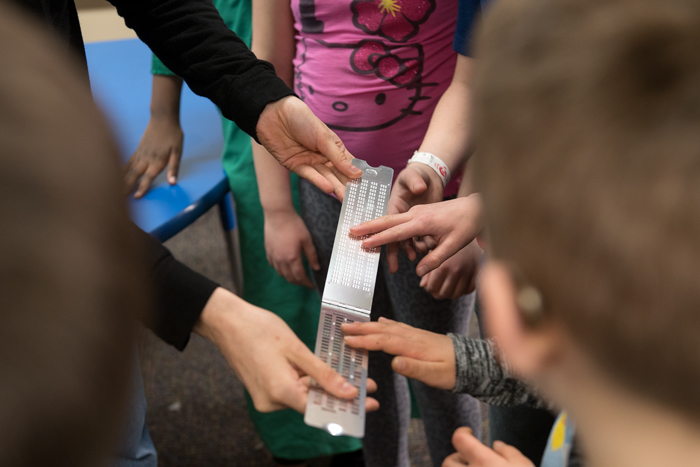
“A lot of people just want to pass,” Harris describes. “A DeafBlind student may think, ‘I may strain my eyes and have to sit really close and use a huge font, but that’s normal. That’s what I have to do.’ Some DeafBlind people—who are clearly not comfortable walking because they can’t see where anything is—still refuse to use a cane. If they use a cane, then everyone will know they are DeafBlind.”
Additionally, Harris noticed that her Deaf students were inadvertently leaving DeafBlind students out. Without realizing it, she says, they used sign language where DeafBlind students couldn’t see, spoke about them when they weren’t looking and carried out fast conversations without making sure DeafBlind students could access them. At times, Harris says DeafBlind students were excluded due to the extra effort it might take to include them. “I would watch the DeafBlind kids, the way they would try to visually follow, and I could tell they were missing things,” she describes. “They either didn’t feel comfortable speaking up for themselves, or they’d had that conversation and didn’t feel like having it again.”
In contrast to trying to “make it” in an environment designed for Deaf people, students whose schools offer DeafBlind pedagogy gain critical access to many of the educational and social experiences they may otherwise miss. DeafBlind pedagogy employs pro-tactile communication, a full-body contact method of sharing thoughts and information. Pro-tactile communication is one of the strategies used by interveners, assistants who help DeafBlind students track conversations in the classroom. (Other strategies include object cues and touch signals.) Yusuf Abdullahi, a ninth-grader at Metro Deaf with Usher syndrome, describes how an intervener might communicate with him: “Someone will sign in my hand. Or they will stand behind me and tap on my back. We’ve got different regions on the back, so if somebody is talking to me on my right, they will tap on the right on a specific spot on the right side. Or they’ll tap different spots down my arm to tell me who is where and what’s being said. By tapping on my back or down my arm, I will know in which direction to look. Then I can look and make eye contact with them.”
Harris understood that within Deaf culture, deafness is seen as an issue of accessibility, rather than a disability. She wanted to extend that framework to include DeafBlindness by increasing her DeafBlind students’ access to all of their options.

I’m really proud of who I am. I’m not embarrassed at all. If I need a cane, I’m going to use a cane.
Designing a DeafBlind Club
Harris designed her DeafBlind club to address the underrepresentation of DeafBlind students within Deaf school culture on two fronts. First, the club would take direct action by hosting DeafBlind social events, interviewing DeafBlind role models, creating educational materials to display at school and taking field trips to visit DeafBlind people at work.
Second, the club would promote knowledge of DeafBlind culture and incorporate it into the school community. Members would share cultural materials with families and school community members. DeafBlind adults would teach after-school activities and visit social studies classes to share their life experiences. To put her plan into action, Harris applied for a Teaching Tolerance Educator Grant. The grant helped pay for DeafBlind adults’ and their assistants’ transportation to Metro Deaf, as well as the cost of materials.
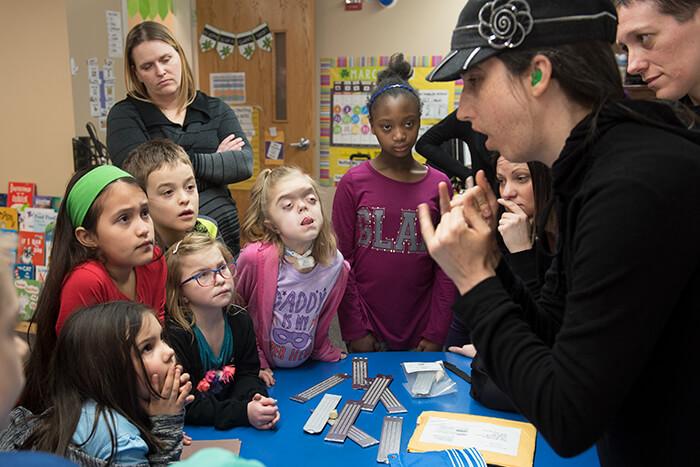
Since its inception, Harris’s DeafBlind club has met monthly. Student participants have built relationships with DeafBlind adults, experimented with tactile art using Play-Doh and explored tactile mazes and games together. John Lee Clark, a DeafBlind Braille artist, has visited the club, and other DeafBlind adults have come to teach tactile skills such as pouring water without spilling, changing diapers, chopping apples with sharp knives and finding the right key to open the front door. While a simple action like putting a twist tie on a bread bag may come naturally to sighted individuals, a DeafBlind student may not have the opportunity to learn through observation. Harris’s DeafBlind club addresses these gaps in the basic-yet-essential knowledge bank that many in the hearing and sighted world take for granted.
Overall, students say the club has been a huge success. Yusuf sees the club as a support group where members learn from one another. “Now, if I have a question about something or about their experiences specifically, I email them,” he says. “I ask them, ‘How do I get access to this particular thing?’ Or, ‘I’m feeling frustrated here. How do I go about resolving it?’”
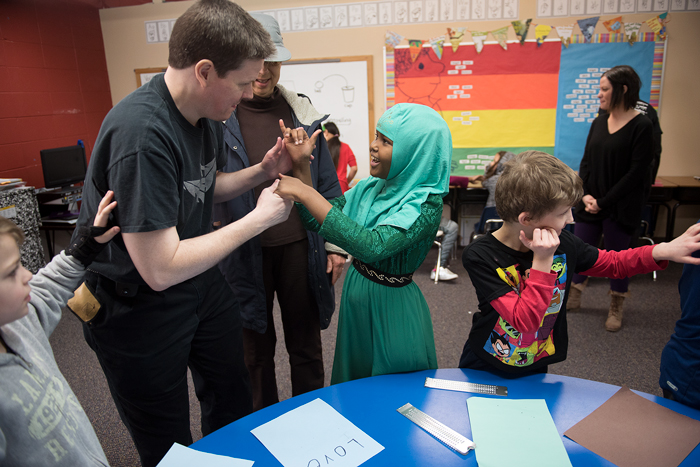
Harris strives to rewrite a narrative of disempowerment in her DeafBlind club by letting the participants take control. “I’m not DeafBlind,” she says, “and I don’t want to be the one to take over as a person of privilege. I don’t want to say, ‘OK, this is how you’re going to do it.’”
Initially, details like room configuration presented an issue. Guest artist John Lee Clark noticed that the desks were arranged to accommodate Deaf students. While the desks were configured so that Deaf students could best see one another, to DeafBlind individuals, they were in the way. “In a DeafBlind-friendly environment, the desks would be gone,” says Harris. Midway through the year, the desks are finally out of the way. While the club speakers initially looked to Harris for instruction, she worked to decenter herself from the outset. “They were constantly turning to me like, ‘Well, what should we do?’ I said, ‘You’re the DeafBlind adults, what do you think is important for DeafBlind kids to know?’”
Intersecting Identities: Religion and DeafBlindness
DeafBlind communication is tactile, and Metro Deaf has several Muslim students. Within some Muslim cultures, nonlinguistic social touch is prohibited between males and females outside of marriage. However, in Muslim-majority countries, linguistic touch (for language, or to get someone’s attention) between teachers and Deaf or blind students is allowed because there is absolutely no sexual connotation. DeafBlind Muslim students may not understand this distinction if they do not have full access to their family’s oral cultural conversations at home. Or, they may be confused about how cultural rules extend to interactions at school.
If a female student learns at home that they’re not allowed to touch a boy (or vice versa), they may wonder, “What do I do at school?” They may ask, “If I’m DeafBlind and we learn Braille with my teacher’s hands under my hands or on top of my hands, how does that work?” They may feel nervous about breaking a rule they don’t understand or don’t know about. If a DeafBlind adult male comes in to talk with girls, or a female teacher needs to communicate with boys, it may present a conflict.
A Deaf Muslim adult at Metro Deaf has been working with students to explain that linguistic touch is OK within Muslim cultures. But most of the DeafBlind adults are not Muslim. “Leaders in the community say, ‘They’ll just have to get over it,’” Harris observes. “Or they’ll say, ‘We have to touch. Just do it.’ They may not realize that could be a huge cultural and religious conflict.”
Harris received a fellowship to go to East Africa this summer to learn about culturally appropriate DeafBlind education. She plans to bring back the practices she observes in the DeafBlind community there to her students in Minnesota.
“People have told me that Deaf and DeafBlind communities in Muslim-majority communities do use touch,” she says. “But I want to see for myself.”
A Cultural Shift
Harris’ work with her DeafBlind club represents a cultural shift within the school community. Metro Deaf students and staff, the majority of whom are Deaf, are being trained in pro-tactile sign—a paradigm shift from visual to full-contact communication. “It’s a huge cultural shift for me to suddenly walk up to everybody and start touching them,” Harris says.
Outside of school walls, the Twin Cities DeafBlind community is strong. At the Mall of America, DeafBlind adults gather regularly for DeafBlind happy hours in the food court, where they build relationships, practice pro-tactile sign and develop their tactile life skills.
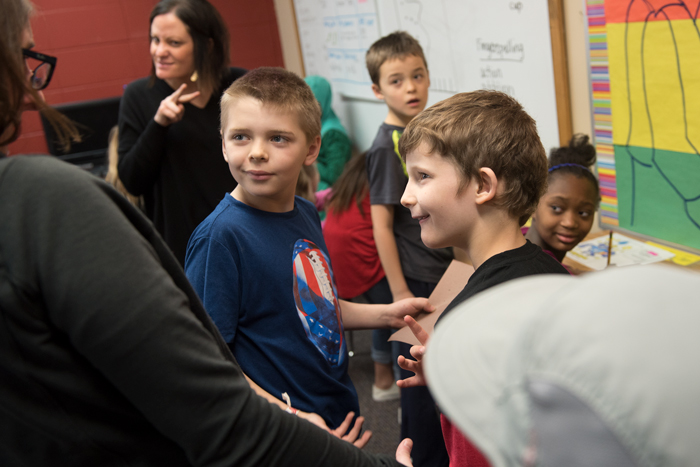
Within the broader disability narrative, DeafBlind education advocates are moving away from the triumphant image of Helen Keller “overcoming the odds” and toward more positive stories of plurality and nuance. “When the media portrays the problem as the disability, society is not encouraged to change,” DeafBlind disability activist and lawyer Haben Girma states. “The biggest barriers exist not in the person, but in the physical, social and digital environments.”
Patti McGowan, parent of a DeafBlind college student with Usher syndrome, emphasizes the importance of pre-teaching, reteaching and allowing time to process information. “With DeafBlindness, routines are important. The student does not know what he or she may not see or hear,” she says. “Pre-teach: ‘This is what’s going to happen. This is what’s coming next.’ Then you reteach: ‘This is what you just learned.’ Or work with an intervener who can say, ‘OK, we’re going to go into chemistry, and this is the new material that’s going to be taught today’ and be the bridge of accessing the information for the student.”
Assistive technology and accommodations such as captions, transcripts, image descriptions and machine-readable text can mean the difference between failure and success for a DeafBlind student. When accommodations run smoothly, DeafBlind students can keep pace with their classmates. “If the supports are set in place, my son does well,” McGowan explains. “His accommodations allow him to be in competition with his peers. Assistive technology gives him fair playing ground.”
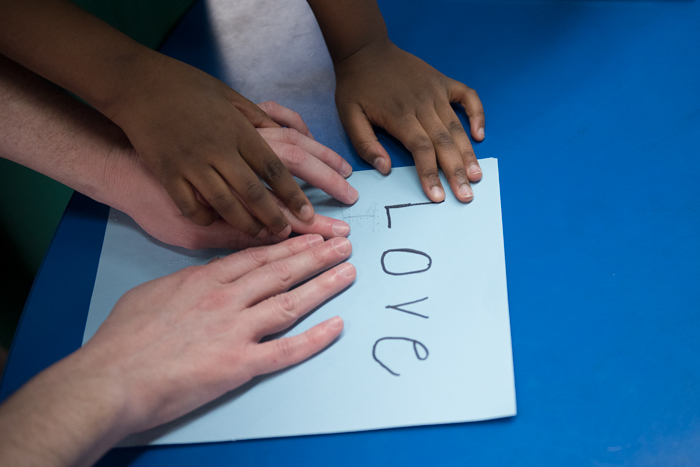
Finally, practicing solidarity is key. Harris says she began carrying a cane inside the school building to reduce the stigma of using one at Metro Deaf and to help a student work her way up to using one. “I’m not blind,” Harris says, “but I use my cane every day so it’s a normal thing because there aren’t any adults around here who use a cane every day.”
Harris is adamant about not using her cane outside of school to avoid appropriating a disability that is not her own. With her students, however, she says it helps her respond to the questions and reactions that arise. “I’m modeling for students,” she says. “I’m practicing my skills. When my kids say, ‘I can’t get my lunch tray,’ I can say, ‘Hey, this is how I do it,’ because I’ve done it. I’ve had to carry my computer and my water bottle and my cane and open the door. I tell them, ‘Let’s talk about how I figured out how to do it.’” While Harris’ practice serves some of her students, she recognizes that others may not need the same support. “I’m really proud of who I am,” affirms Yusuf, for instance. “I’m not embarrassed at all. If I need a cane, I’m going to use a cane.”
In the future, Harris would like to fulfill John Lee Clark’s recommendation to install subwoofers at Metro Deaf. Subwoofers would vibrate to signal the beginning and end of class periods, as the school’s flashing orange lights are not currently accessible to DeafBlind students. “Design something that everybody can access,” Harris says, “and everybody benefits.”
Ehrenhalt is the school-based programing and grants manager for Teaching Tolerance.
Have a great idea for a project that can make your school more just, inclusive or accessible? Follow Wendy Harris’ lead, and apply for your own TT grant!
